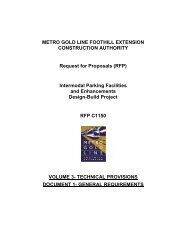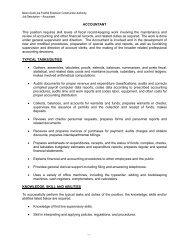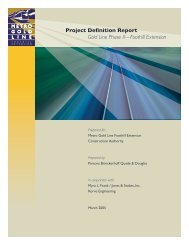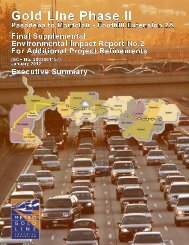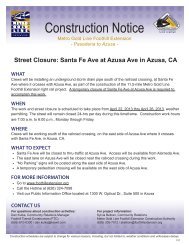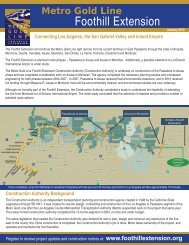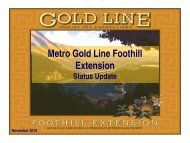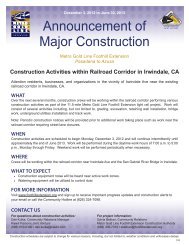Interview with Design Concept Advisor Andrew ... - Metro Gold Line
Interview with Design Concept Advisor Andrew ... - Metro Gold Line
Interview with Design Concept Advisor Andrew ... - Metro Gold Line
Create successful ePaper yourself
Turn your PDF publications into a flip-book with our unique Google optimized e-Paper software.
<strong>Interview</strong> <strong>with</strong> <strong>Design</strong> <strong>Concept</strong> <strong>Advisor</strong><br />
<strong>Andrew</strong> Leicester<br />
Q: Why did you choose to engage in public art as an artistic practice?<br />
Media Contact:<br />
Lisa Levy Buch<br />
Director of Public Affairs<br />
MGLFE Construction Authority<br />
(626) 305-7004 or (909) 267-0161 cell<br />
llevybuch@foothillextension.org<br />
AL: As a young kid growing up in the English countryside, I would explore disused and abandoned quarries,<br />
old canals, viaducts, industrial plants and brick kilns. It was fascinating to see this industrial archeology in<br />
complete ruin and covered in ivy. Those forms had the look of ancient funerary and ritual architecture and<br />
resulted in my first thoughts about a possible career focused on art and architecture.<br />
I studied physical geography—understanding landforms and how humans have altered them such as<br />
redirecting rivers. I love landscape and its scale. I wanted to work on a level where the artwork is<br />
commensurate <strong>with</strong> the mass of the surrounding landscape as well as <strong>with</strong> the urban infrastructure.<br />
How art functions in the context of a specific community and its environment is a particular interest of<br />
mine as seen in my earliest works, which were primarily land art and environmental installations<br />
documenting erosion over time.<br />
To me public art is encountered in everyday life and, as a result, has a huge audience <strong>with</strong>out requiring the<br />
viewer to go to a specific space to see it. Unwittingly, people experience art in an environment over<br />
saturated <strong>with</strong> other visual stimuli.<br />
Q: How did working <strong>with</strong> the <strong>Metro</strong> <strong>Gold</strong> <strong>Line</strong> Foothill Extension Construction Authority differ from some<br />
of your prior commissioned projects?<br />
AL: It was an extraordinarily unique opportunity. Within the Request for Proposals link was a video <strong>with</strong><br />
Habib Balian, CEO of the Construction Authority and art consultant Lesley Elwood standing at the bridge<br />
site by the freeway, describing how they wanted an artist to create the concept for the bridge from the<br />
start. I could not believe it and was intrigued that the artist was not an afterthought as is the case in so<br />
many public projects.<br />
I immediately started working on ideas and researching the area before flying to Los Angeles for the<br />
interviews to present my sketchbooks demonstrating my creative process. Being involved from the<br />
beginning really allowed me to impact the overall gestalt. I am deeply grateful to Habib for his leadership<br />
and commitment to quality that ensured the bridge adhered to the original concept.
<strong>Interview</strong> <strong>with</strong> <strong>Design</strong> <strong>Concept</strong> <strong>Advisor</strong>, <strong>Andrew</strong> Leicester, Page 2 Updated: 10/23/12<br />
Q: What was the creative evolution of the initial concept for the <strong>Gold</strong> <strong>Line</strong> Bridge?<br />
AL: The Construction Authority set the mandate for me to create a unique gateway that reflected aspects of<br />
the San Gabriel Valley region. As <strong>with</strong> all public art projects, it involved many conversations <strong>with</strong> the<br />
community, listening to their responses and incorporating their input in my preliminary sketches.<br />
Understandably, people in the community have a better intuition about local history, myths and legends.<br />
Their responses and reactions guided my steps. The crucial synthesis springs from this exchange of ideas,<br />
and the cycle is repeated eventually leading toward a final concept. Hopefully, the end result resonates<br />
<strong>with</strong> the community—a multi-layered composition that people perceive as once both clear and ambiguous.<br />
I drew my inspiration from two sources: the region’s cultural history and its architecture. The large baskets<br />
that adorn the bridge metaphorically represent the Native Americans of the region and the growth of<br />
agriculture as a primary catalyst to the San Gabriel Valley. They also pay tribute to the iconic sculptural<br />
traditions of Route 66 <strong>with</strong> its oversized commercial architecture such as the windmill atop the Denny’s<br />
restaurant on Huntington Drive and the Maya restaurant on Foothill Boulevard north of the freeway. The<br />
bridge’s baskets join this pantheon of larger-than-life artifacts.<br />
The central theme of my design concept truly celebrates aspects of the early cultures of the San Gabriel<br />
Valley. In addition to celebrating these people, it seemed appropriate to reflect the centuries-old migratory<br />
history of the area. Prior to the Spanish missions, these ancient peoples traveled from the interior desert<br />
states and great basin areas along the San Gabriel Foothills on their way to the ocean.<br />
Some of the most notable and recognizable artifacts of these people’s culture are their elaborately<br />
designed baskets, which served both a utilitarian purpose and as valuable trading commodities. The baskets<br />
as artifacts have survived over the years and are highly prized. Their creation remains an ongoing tradition<br />
to this day.<br />
The making of baskets and bridges share similar fabrication techniques. Both have an internal skeleton of<br />
interwoven linear material to describe the form, reed and rebar respectively, and filler and surfacing<br />
material to give rigidity—stem and clay for the basket and concrete for the bridge. Hence, the skeleton and<br />
its skin are manipulated to give expressive meaning as well as provide utility.<br />
The basic bridge is comprised as a carriageway (where the train will run) that is supported by a cross beam<br />
across the I-210 freeway that is in turn supported by two vertical columns on either side of the freeway.<br />
This simple arrangement creates a giant de facto "post and lintel” doorway for eastbound motorists.<br />
Adding to its immensity is the serpentine carriageway, representing the Western Diamondback, above <strong>with</strong><br />
its exposed “ribs.”<br />
Q: Can you explain your creative process for the <strong>Gold</strong> <strong>Line</strong> Bridge project?<br />
AL: I did research for over a year, designing and presenting preliminary ideas to the Construction Authority<br />
in person and via emails and conference calls while also including feedback from a group of community<br />
stakeholders representing the corridor’s cities from Pasadena to Montclair.<br />
The original concept for the bridge included using a variety of materials. Following a Caltrans and <strong>Metro</strong><br />
review; however, it was determined that the bridge should only be constructed in concrete for<br />
maintenance and safety reasons (soil borings had confirmed the existence of the active Raymond Fault<br />
<strong>Metro</strong> <strong>Gold</strong> <strong>Line</strong> Foothill Extension Construction Authority, 406 E. Huntington Drive, Suite 202, Monrovia CA 91016 - (626) 471-9050
<strong>Interview</strong> <strong>with</strong> <strong>Design</strong> <strong>Concept</strong> <strong>Advisor</strong>, <strong>Andrew</strong> Leicester, Page 3 Updated: 10/23/12<br />
running directly underneath the bridge). Special seismic engineering required sinking foundations more<br />
than 100 feet down and beefing up the three main columns and adjusting the profile of the baskets and<br />
main crossbeam.<br />
As is often the case <strong>with</strong> a public art process, an artist has to be prepared to start from scratch when there<br />
are material and design criteria that dictate the direction and constructionability of a project. These<br />
challenges are par for the course for public artists. I presented half a dozen ideas before the Construction<br />
Authority approved the final design concept.<br />
The next task was to engineer the various components—the reeds, baskets and serpentine skeleton of the<br />
bridge—to pass a Caltrans review. The engineering crew addressed these intricacies well and understood<br />
how we would execute all the elements while still preserving the visual integrity. The architect Rivka Night’s<br />
advice and amazing skills <strong>with</strong> the many complex computer drawings and calculations were crucial.<br />
Q: What sort of inspiration do you hope the bridge will provide to the community?<br />
AL: Route 66 (Foothill Boulevard) parallels the I-210 freeway. This “California Mother Road” has had an<br />
indelible effect on the minds of most Americans, giving birth to the quintessential American roadside<br />
attraction <strong>with</strong> its larger than life figures and quasi-architectural objects advertising a local attraction. As<br />
history moves ineluctably onwards, cultural shifts wipe out these cultural artifacts as well as traces of<br />
earlier peoples.<br />
This monumental bridge <strong>with</strong> its supporting columns will be a symbolic gateway into the San Gabriel Valley<br />
as well as a tribute to and reminder of the earliest settlers that inhabited this spectacular landscape. In<br />
addition, it emphasizes to the traveler that they have arrived in a unique place—one of the driving<br />
principles behind the art program for the Foothill Extension.<br />
At night, lights will illuminate the baskets, creating spectral sentinels for those who are driving along the<br />
freeway or taking the train—something passengers will look forward to as a landmark on their journeys. As<br />
I mentioned before, the average person does not ordinarily encounter art in their everyday environment. I<br />
want people to be intrigued by the mystery of it.<br />
As <strong>with</strong> most ceremonial portals, the addition of symbolic and decorative elements serves a vital role in<br />
conveying a message to anyone who passes through. In this case, they announce the beginning of the San<br />
Gabriel Valley, and to those that live there, ‘you are not far from your destination.’ The bridge provides that<br />
warm, confident feeling of heading home.<br />
###<br />
<strong>Metro</strong> <strong>Gold</strong> <strong>Line</strong> Foothill Extension Construction Authority, 406 E. Huntington Drive, Suite 202, Monrovia CA 91016 - (626) 471-9050



